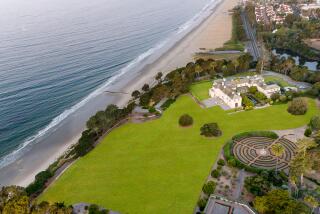Ruth Newhall Puts Out the Welcome Mat at Piru Mansion
- Share via
If you or your mom are on the lookout for something a little different this Mother’s Day, head for Piru and visit the elegant Victorian mansion that sits on a hillside overlooking this little town.
It’s a rare opportunity to see the lavishly ornate interior of the home of Ruth Newhall, widow of crusading newspaperman Scott Newhall, whose great-grandfather founded the communities of Newhall and Saugus.
The three-story home will be open Sunday for tours from 11 a.m. to 4 p.m. The $10 admission benefits the Fillmore-Piru Boys & Girls Club. (Visitors should park at Piru School, on East Center Street, where a shuttle bus will be provided.)
The long driveway to the Queen Anne-style house passes fragrant orange orchards and manicured grounds. The outside alone is a treat to look at. A massive stone tower rises on one side. On the other, a smaller, circular tower is topped with a carved bird, a phoenix.
The bird is symbolic to the Newhalls because the 11,550-square-foot house rose from the ashes. Originally built from 1886 to 1890, the mansion was bought by the Newhalls in 1968. They spent years restoring the place, and in 1981 a spark from a workman’s torch ignited the structure, burning it to the ground. All that remained were the floor tile, part of a tower and two chimneys.
“We rebuilt it exactly as it was,” Ruth Newhall said. It was a painstaking process. Using photographs and rounding up craftsmen who had worked on the restoration, the couple faithfully reproduced the redwood exterior siding, the intricately carved, mahogany-trimmed interior, and the colorful stained glass that graces nearly all the windows.
“We were busy for two or three years,” said Newhall, 85, whose husband died in 1992. “We worked very hard on it.”
In case you’re in the market for a house with a tower, this one is for sale. The asking price is $2.3 million, though Newhall said she isn’t marketing it aggressively.
“I’ve loved being here,” she said. “There’s no sense in one woman with a housekeeper occupying all this space.”
Newhall will lead some of the tours Sunday. In the living room, dark, rich mahogany rules. Every doorway, window or fireplace is an opportunity for the carved woodwork. The book-lined library serves as a sort of family room, though one from a different era.
“This is the room we seem to gather in,” said Newhall, who raised four children. “We’d sit around the table and play Scrabble or chess.” A TV is hidden behind mahogany doors.
The mansion has been dubbed the poor man’s Hearst Castle, in part because Scott Newhall, like William Randolph Hearst, was involved with a San Francisco newspaper--Newhall pumped new blood into the San Francisco Chronicle while he was editor from 1952 to 1971. And like Hearst, he enjoyed tinkering with big houses. In one guest bathroom, he installed the temperature dials from an old steam tug boat and rigged them up to a teak bathtub. In the kitchen sits another find--an 1868 Danish stove with green floral decorations.
The Newhalls have stayed true to the original Victorian house, except for a few necessary improvements. They added bathrooms, but kept the original outhouse for sentimental reasons. The frieze around the living room was their touch. The kitchen has been modernized too.
“This is nothing like the original,” Ruth Newhall said of the kitchen. “It had one bare bulb--it was awful.”
In an upstairs bedroom, a huge circular window provides an expansive view of the valley. Oddly, a big painting of the original house ablaze graces the master bedroom. Adjacent is an enormous marble bathroom.
In his study sits Scott Newhall’s Royal manual typewriter. After leaving San Francisco, the couple took over the Newhall Signal and ran the community newspaper with flamboyant style until 1988, when they left to start the Valley Citizen, a renegade twice-weekly publication that died eight months later.
As a youth, Scott Newhall was taken with the Piru mansion. It was designed by Samuel and Joseph Cather Newsom, well-known Victorian architects in California. The house was built for David C. Cook, who founded an Illinois publishing company. Cook moved to California because of ill health. Having gotten a Mexican land grant, he laid out the town of Piru, put up a hotel and church, and then erected the mansion. Cook’s intent was to turn the property into a fruit ranch, and following the Bible, he planted dates, grapes, pomegranates, olives and other fruits.
Today olives and pomegranates thrive in the town and on the hills near the house. The grounds behind the mansion, though, are carefully groomed and landscaped. Italian sculptures decorate the patio and swimming pool.
Visitors who tour the mansion Sunday may picnic on the grounds.
DETAILS
* WHAT: Tour of the Newhall mansion in Piru.
* WHEN: 11 a.m.-4 p.m. Sunday.
* WHERE: Park at Piru School, 3811 E. Center St., Piru. A shuttle bus will take visitors to the mansion.
* HOW MUCH: $10 donation to benefit the Fillmore-Piru Boys & Girls Club.
* CALL: 525-7910
More to Read
Sign up for The Wild
We’ll help you find the best places to hike, bike and run, as well as the perfect silent spots for meditation and yoga.
You may occasionally receive promotional content from the Los Angeles Times.






